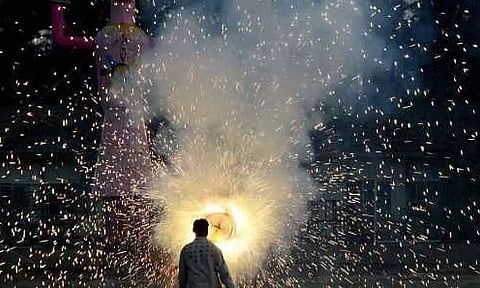

NEW DELHI: In the run-up to Deepavali, a gamut of issues has been flagged by citizens, healthcare professionals and scientific experts. Air pollution was on everyone’s minds, considering the indictment delivered on New Delhi last week. The national capital was referred to as India’s most polluted city in the last five years, during the month of October. Consequently, the Delhi Pollution Control Committee (DPCC) notified a blanket ban on firecrackers across the capital till January 1, 2024. The ban includes the manufacturing, storage, bursting and sale of all types of crackers, including green crackers.
In Chennai, 18,000 cops have been assigned on special Deepavali duty to ensure that fireworks are burst only during the time period stipulated by the Supreme Court — an hour each in the morning and evening. It’s anybody’s guess as to how compliant revellers are going to be, with regard to the instructions. Which brings us to the point, when exactly did Deepavali transform into this harrowing ritual of indiscriminate and deafening pyrotechnics?
The Noise Pollution (Regulation and Control) Rules 2000 has directed that firecrackers cannot be burst in ‘silence zones’ which are designated by the State government, such as hospitals, government buildings among others. It’s also worth noting that the standard for acceptable noise levels (decibels) during day and night hover around 55 to 45 dB(A) in residential areas, 65 to 55 dB(A) in commercial regions, and 75 to 70 dB(A) in industrial locations. However, during Deepavali, firecrackers frequently breach the 90 dB mark.
Noise levels exceeding 80dB(A) in office settings are linked to episodes of hypertension, whereas an exposure of over 50 dB(A) during night could lead to a surge in cortisol levels, a conduit for anxiety-related ailments. The vision, breathing, and hearing-related issues affecting the elderly and health-compromised individuals is one side of the story. Deepavali also happens to be a nightmare for four-legged and winged creatures.
The festive season is when animal shelters across Chennai are bombarded with phone calls and walk-ins, related to numerous accidents involving domesticated pets and birds as well. House cats and dogs are especially sensitive to loud noises and they tend to panic in the aftermath of explosions. Just this week in West Bengal, a young horse belonging to the Kolkata Mounted Police succumbed to a heart attack after being spooked by fireworks, following an India-South Africa World Cup match. The horse, which was ironically named Voice of Reason, was on duty with his handler when the fireworks went off. This caused him to panic and charge towards the parking lot, and later collapse.
Yes, Deepavali is the one time of the year that workers in the water-scarce region of Sivakasi, India’s fireworks hub, make some money from the toiling. Having said that, improvements in their working conditions remain a pipe dream for decades together. It was just a month ago that 14 workers died in blasts in two fireworks manufacturing units near Sivakasi. Inexperienced handling and unsafe, non-standardised storage were zeroed in as the causes behind the blast. Obviously, there’s a need to enforce strict adherence to industrial safety norms, vis-a-vis the fireworks industry. The employees of such enterprises also need to be upskilled to reduce their dependence on a single source of income. But above all, the government must lend credence to the notion of air, noise, light and ecological pollution, and consider the option of setting stringent thresholds on these variables that can be implemented in letter and spirit.